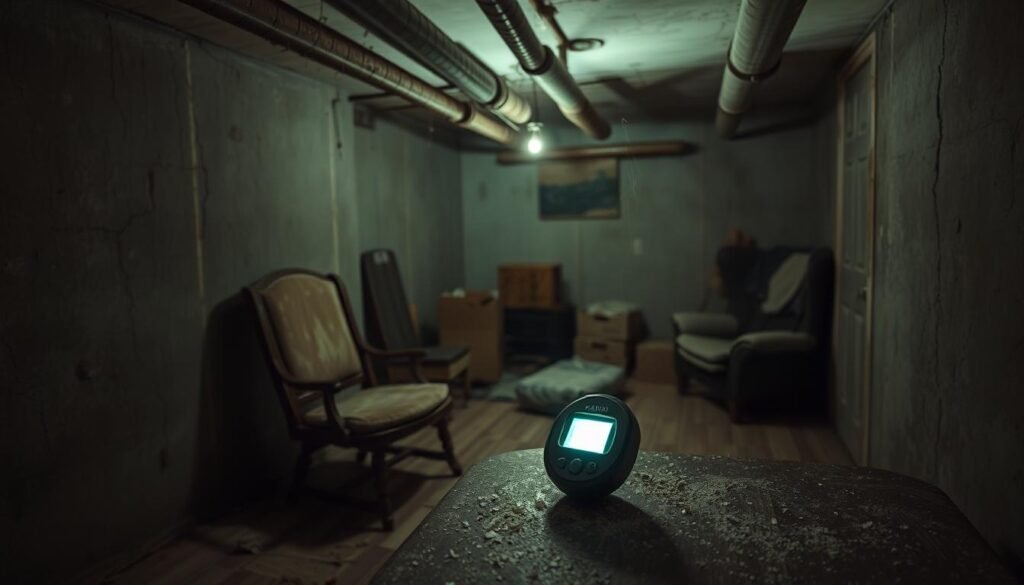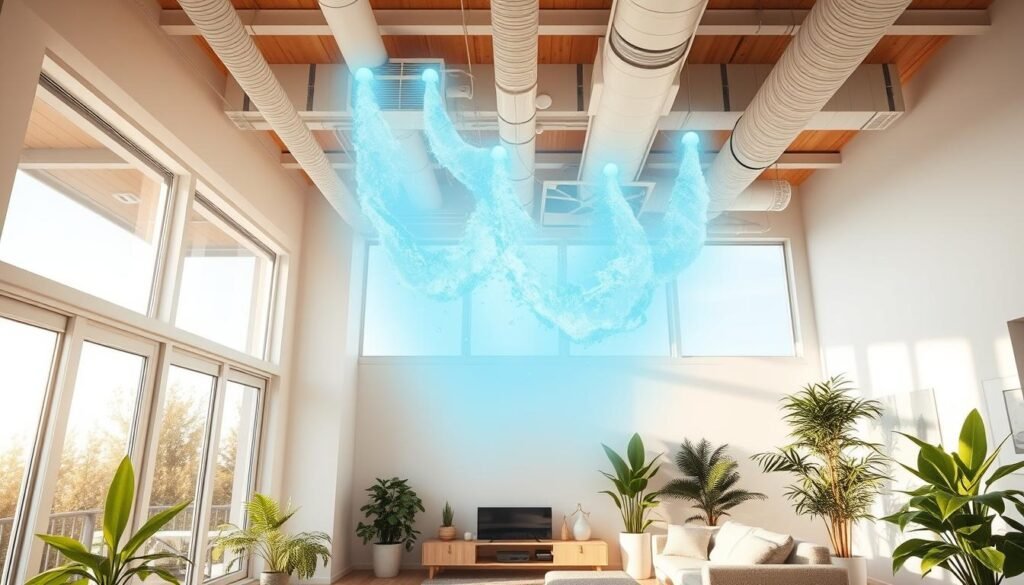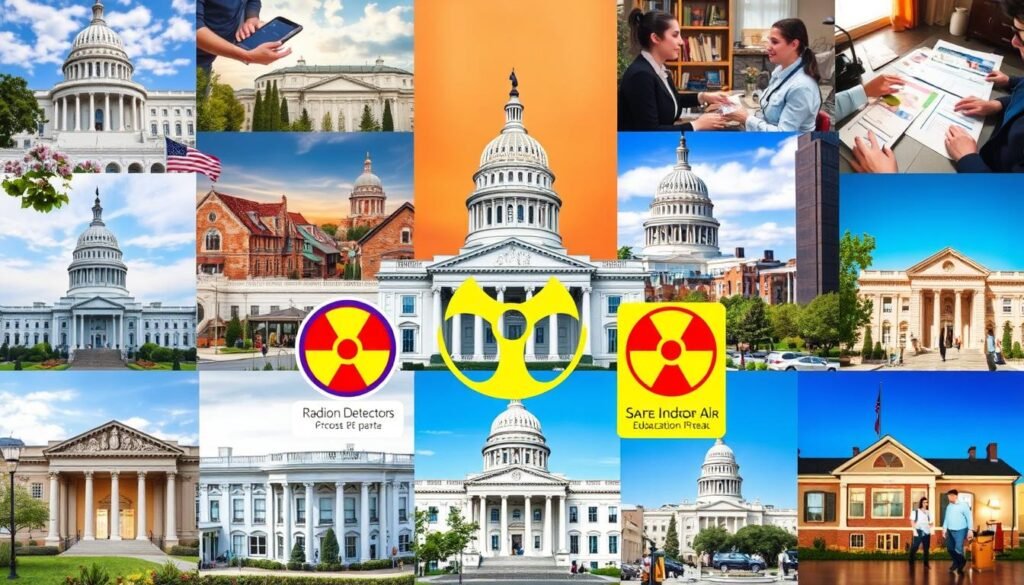Did you know radon causes over 21,000 lung cancer deaths yearly in the U.S.? This fact shows why it’s vital to know the risks of radon in homes and workplaces. Radon is a natural radioactive gas that can build up inside, posing big health risks. So, it’s critical to use methods to reduce these dangers for safer living and working areas.
It’s important to be aware and take early steps to avoid health problems from this hidden danger. Every home and workspace needs to manage radon. This is not just for meeting safety rules but also for everyone’s health. Learning about radon, its health risks, and how to lower exposure is the first step toward safety.
Key Takeaways
- Radon is a leading cause of lung cancer in the U.S., responsible for over 21,000 deaths annually.
- The EPA recommends taking action if radon levels reach 4 pCi/L or higher.
- Children may be at greater risk due to differences in lung design and breathing rates.
- Effective radon reduction often requires professional expertise for comprehensive solutions.
- No level of radon is considered completely safe; actions to lower exposure are always beneficial.
- Testing and monitoring radon levels should be a routine practice in both homes and workplaces.
What is Radon?
Radon is a natural occurrence, yet many do not know about it. It is important for indoor air quality. Radioactive gas that is colorless, odorless, and tasteless. This makes it hard to detect without testing. It comes from the decay of uranium and radium in soil, rock, and water. Knowing about radon is key for those worried about health risks.
Definition and Nature of Radon
Radon is a noble gas coming from the decay of uranium. This decay happens over time, releasing radon into the air. Once formed, it can enter buildings through cracks in floors and gaps around pipes. Homes usually have 1.3 picocuries per liter of radon, higher than outdoors which is around 0.4 pCi/L.
Origin of Radon Gas
The origin of radon comes from its parent elements, uranium and radium. These elements are found in the earth’s crust. Over time, they break down and form radon gas. This gas can enter buildings, affecting air quality. In the US, about one in 15 homes has high radon levels, over 4.0 pCi/L. This highlights the need for awareness and testing.
Health Hazards Associated with Radon Exposure
Radon is known for its health risks, especially its link to lung cancer. This radioactive gas can build up inside, especially in basements and low levels. Over time, this can lead to serious health problems.
Lung Cancer Risk from Radon
In the U.S., radon is the second leading cause of lung cancer after smoking. Every year, it causes about 21,000 lung cancer deaths. Interestingly, 10% of these deaths are non-smokers. This shows how radon is a risk for everyone. Studies have found that long-term radon exposure increases lung cancer risk. This risk goes up by 16% for every 100 Bq/m3 increase in radon levels. Radon and its decay products can be breathed in or swallowed, posing big health risks.
Statistics on Radon-Related Deaths
Radon is a serious public health issue. It’s behind 3 to 14% of lung cancers worldwide. The EPA says reducing radon levels below 4 pCi/L could cut lung cancer deaths by 2 to 4%. This could save about 5,000 lives every year. This information highlights the urgent need to tackle radon exposure in our living and working spaces. For detailed info on radon health risks, you can check the World Health Organization guidelines.
Radon Levels: Understanding Measurements and Standards
Understanding radon levels is crucial for health safety at home and work. It’s important to know how these levels are measured. Knowing the standards set by authorities helps us respond right.
EPA Guidelines for Radon Levels
The EPA Guidelines state that action is needed when radon levels hit 4 picocuries per liter (pCi/L) or more. Lowering radon levels below this point greatly reduces cancer risks. Health organizations worldwide stress the need to keep radon at minimal levels.
Radon Measurement Units Explained
Radon levels are usually measured in picocuries per liter (pCi/L) or becquerels per cubic meter (Bq/m³). Understanding these Measurement Units is key in checking air quality. For instance, outdoor radon levels average around 0.4 pCi/L. But indoor levels can be much higher, up to 1.25 pCi/L, raising health concern.
Knowing about measurement units and health guidelines helps us prevent and fix radon issues. Regular checks are advised, especially in high radon areas. This ensures safety from radon.
Radon Exposure in Homes and Workplaces
Understanding common sources of radon indoors helps us stay safe. Radon gets in through cracks in floors and walls, gaps in construction, and foundation walls. It often builds up in basements with little air flow, leading to more radon exposure. Knowing this helps us keep our indoor air healthy.
Common Sources of Radon in Indoor Environments
- Cracks in floors and walls
- Construction joints
- Foundational walls
- Basements with poor ventilation
Risk factors for radon exposure are different at home and work. Homes near uranium-rich soil have a higher radon risk. It’s important to check radon levels at work too, especially in certain areas. This keeps everyone safe. Homes are often more exposed to radon than workplaces, showing the importance of testing our homes.
Risk Factors in Residential and Occupational Settings
- Proximity to uranium-rich soils
- Lack of regular radon assessments
- High indoor concentration levels due to poor ventilation

It’s key to lower radon risks. Making homes safer from radon helps prevent lung cancer, a top cause of cancer deaths. Since radon links to many lung cancer deaths each year, promoting awareness and action creates safer indoor spaces.
Testing and Monitoring for Radon
It’s super important to test and monitor radon levels in our homes and workplaces. Radon is a gas that you can’t see or smell. It can build up indoors and is harmful to our health. So, keeping an eye on radon levels keeps everyone safe from health risks.
How to Test Your Home for Radon
Testing your home for radon is something you can do on your own. You can find radon testing kits at hardware stores or online. There are short-term and long-term kits. Short-term kits show radon levels from 2 to 90 days and give quick results. Long-term kits stay in your home for over 90 days and give a better average of radon levels through the year. To get the best results, test your home during the colder months when windows and doors are mostly closed.
Monitoring Radon Levels in Workplaces
Workplaces, especially in areas with high radon levels, need regular radon checks. Employers should hire radon experts to keep an eye on the levels. If radon levels hit 4 pCi/L or more, it’s time to get a pro to fix the problem. Keeping track of radon helps follow health rules and keeps everyone at work feeling safe.
Dealing with radon in homes and offices means testing and keeping track of levels regularly. After fixing any radon problems, retest to make sure the levels are still safe. Since radon causes many lung cancer deaths each year, it’s crucial to stay ahead with tests and monitoring. This can really save lives.
Building Ventilation and Radon Management
Proper building ventilation is key in handling indoor radon levels. It allows air to flow well, which helps spread out radon gas. This reduces its concentration in homes and workplaces. Making sure air moves freely is vital for a healthy indoor environment.
Importance of Proper Ventilation
Good ventilation greatly affects indoor radon amounts. More air moving through helps lower radon exposure. It also improves the air we breathe inside. By adding the right ventilation, we can lessen the dangers of radon.
Methods to Enhance Indoor Air Quality
To better manage radon, various approaches can be used. These strategies include:
- Using exhaust fans to move air.
- Opening windows to let in fresh air.
- Adding mechanical ventilation for constant air flow.
- Sealing cracks to keep radon out.
- Covering floors in basements to stop radon entry.
These actions help in fighting radon and keeping indoor areas safe. For more tips on reducing radon risks, check the CDC’s advice.

Mitigation Strategies for High Radon Levels
It’s vital to tackle high radon levels to keep the air inside safe and healthy. There are key strategies to lessen the danger of radon exposure. Homeowners and property managers have various ways to effectively reduce radon levels. This protects everyone inside from health risks.
Effective Radon Reduction Techniques
There are many techniques to lower radon inside buildings. Soil depressurization is one effective method. It involves using a vent pipe system and fan to pull radon from under the building and release it outside. This greatly lowers the radon levels indoors.
If radon levels are between 2 pCi/L to 4 pCi/L, the EPA suggests taking action. Fixing this problem can cost as much as usual home repairs. The price for a radon reduction system averages at $1,500. But, the cost may change depending on the home’s structure and needs.
Closing up cracks in the foundation helps these methods work better. It’s also good to check radon levels regularly, like every two years or after making changes to your house. Homeowners can get radon tests from state health departments, such as New York State, for a small fee.
Professional Radon Mitigation Services
When radon levels go over recommended limits, hiring professionals is key. Certified experts have the right skills to create and put in place custom Mitigation Strategies. These plans are made to work with different buildings and construction styles.
For help with high radon levels, experts suggest contacting your state’s radon office or the EPA’s radon proficiency programs. This way, you make sure the steps you take are effective and safe. For example, Carol looked for professional help when she found out her renovated home had high radon levels. She did this to protect her family.
Radon-Resistant Construction Practices
Using the right construction methods can greatly lower radon levels in homes and buildings. These methods aim to prevent radon from entering, creating a safer space for everyone inside.
Building Techniques to Prevent Radon Entry
It’s important to use radon-resistant techniques from the start of building. Some common ways to keep radon out include:
- Installing a gravel layer under the foundation for better ventilation.
- Putting in a vent pipe system to move radon from under the building to the outside.
- Sealing cracks and openings in floors and walls to block radon pathways.
- Choosing certain foundation designs, like a slab-on-grade or a ventilated crawl space, to decrease radon risks.
These methods can make homes much safer from radon. By adding these features early on, homeowners can feel secure against radon risks.
Benefits of Radon-Resistant Design
Radon-resistant design is not just about blocking radon now. It also brings many lasting perks:
- It makes future radon fixes simpler and cheaper, as these homes often need less work.
- Improves the air quality inside, making for a healthier living space.
- May raise the home’s value, appealing to buyers who care about health and the environment.
Choosing radon-resistant construction is a smart move for any home. It blocks radon entry and makes your home safer and more appealing.
| Feature | Impact on Radon Entry |
|---|---|
| Gravel Layer | Allows ventilation, reducing radon accumulation. |
| Vent Pipe System | Directs radon outside, preventing indoor buildup. |
| Sealing Cracks | Minimizes radon pathways into the home. |
| Foundation Design | Specific designs can reduce radon infiltration risk. |
Protecting Workers from Radon Exposure
Making sure workers are safe from radon at work is key for employers and regulators. It’s important to have good workplace policies for dealing with radon. These should include regular tests for radon levels. They must also educate employees about the risks and how to avoid them.
Workplace Policies for Radon Safety
Employers should create detailed policies that cover:
- Regular radon testing in high-risk areas such as mines, spas, and old buildings.
- Monitoring to keep radon levels low, according to guidelines.
- Employee training on radon dangers and safety steps.
- A clear plan for when radon levels are too high.
Personal Protective Equipment (PPE) Recommendations
For better worker safety, it’s vital to provide the right Personal Protective Equipment (PPE). This gear should include:
- Respirators that filter out radon particles from the air.
- Clothes that protect the skin.
- Devices to check radon levels live during work.
Good radon safety steps and the right PPE can really cut down health dangers from radon. The EU directs worksites to keep radon under 300 Bq/m3, urging ongoing checks and risk management. Keeping workers healthy while meeting these rules improves the safety culture at work.
| PPE Type | Purpose | Recommended Usage |
|---|---|---|
| Particulate-Filtering Respirator | Reduces inhalation of radon particles | In high radon concentration areas |
| Protective Clothing | Prevents skin contact | In work sites with potential radon exposure |
| Radon Monitoring Device | Tracks exposure levels | Throughout work hours in relevant environments |
State and Federal Resources for Radon Issues
Getting the right info is crucial for tackling radon problems. State and Federal Resources provide vital help to those worried about radon. Knowing where to find help is key in controlling radon and staying safe.
Contacting State Radon Offices
Every state has radon offices ready to assist. They offer test programs, advice on reducing radon, and radon education. These offices also guide you through local laws and professional radon services. Reaching out to them keeps you updated on radon in your area.
Accessing EPA Resources for Homeowners and Employers
The EPA has many tools for dealing with radon. Homeowners and employers can learn about testing, reducing radon, and following rules for a safer place. Using EPA Resources helps understand radon dangers and how to guard against them.

| Resource Type | Description | Contact Information |
|---|---|---|
| State Radon Offices | Local support for radon testing and mitigation guidance. | Visit your state’s health department website. |
| EPA Resources | Information on testing, mitigation, and regulations. | www.epa.gov/radon |
| Radon Measurement Tools | Tools and methods for testing radon levels. | Available through local environmental agencies. |
| Professional Radon Mitigation Services | Certified services for reducing indoor radon levels. | Find certified professionals on state radon office websites. |
Additional Health and Safety Considerations
Indoor air quality is key for worker health and safety. We must know about hazards like radon that hurt this quality. Hazards like carbon monoxide and mold are risky too. So, we need to take steps to keep the workplace safe.
Other Workplace Hazards Related to Indoor Air Quality
Things like radon gas, volatile organic compounds (VOCs), and particulate matter can be bad. They come from everyday workplace materials. Checking for radon and other pollutants is crucial. This makes the workplace safer for everyone.
Importance of Comprehensive Safety Plans
It’s important to have safety plans that look at all air quality issues. These plans make work safer for everyone. They lower health risks from bad substances.
For example, dealing with radon may need special systems to cut down its levels. Good safety plans not only keep people safe but also make them more productive. They help create a healthier workspace.
| Indoor Air Quality Issues | Potential Health Risks | Safety Measures |
|---|---|---|
| Radon | Lung cancer, especially in smokers | Regular testing and mitigation systems |
| Carbon Monoxide | Headaches, dizziness, and potential death | Install alarms and regular maintenance of combustion appliances |
| Mold | Respiratory issues and allergic reactions | Moisture control and damage repair |
Conclusion
Radon exposure is a big health risk and is the second big cause of lung cancer in the United States. Studies show that about 21,000 nonsmokers die from lung cancer each year because of radon. It’s really important to know about radon’s dangers, but many people still don’t.
It’s vital to use good ways to reduce radon risks. Testing your home for radon every two to five years is recommended, especially if you’ve made any changes to your house. Knowing about radon levels helps people make their homes and workplaces safer.
To deal with radon risks, we must always be careful. Making more people aware, testing regularly, and using strong safety measures can lessen radon’s dangers. Understanding the serious danger of radon is the first step to taking strong actions that can make our health better.